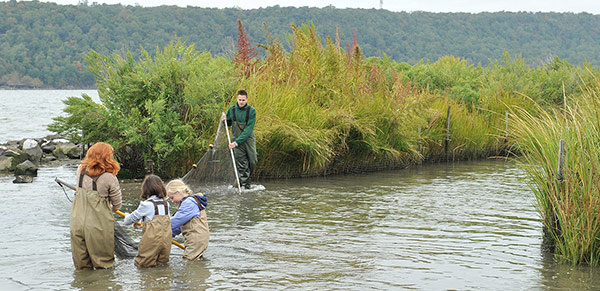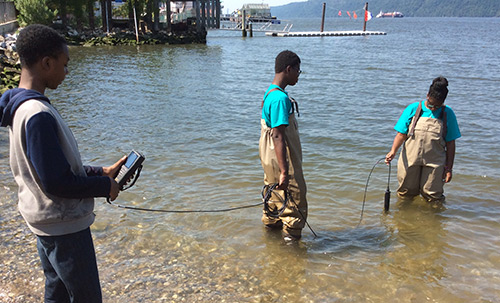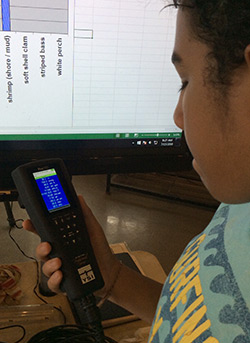Lower-Hudson Environmental Research Facility Gets a Hand
(Updated August 2021)
Situated on the east bank of the lower Hudson River in Yonkers, New York, the Center for the Urban River at Beczak (CURB) engages in environmental monitoring and educational activities for students of all ages. CURB hosts nearly 5,000 K-12 students each year from Westchester County and New York City and annually welcomes nearly 2,000 adult visitors for events, programs, and for those who simply want to enjoy the river. The Center supports a continuous stream of area residents, interested in learning about how societal growth and development impacts the environmental ecosystems of our rivers and watersheds.
Small Center; Big Impact
There are many activities that CURB engages in along the banks of the Hudson River, but their current focus is on four important environmental initiatives:
- Water quality monitoring – Partnering with other regional environmental organizations, CURB measures sewage contamination in the Saw Mill and Hudson Rivers.
- Real-time Hudson River data collection – As part of the Hudson River Environmental Conditions Observing System (HRECOS), CURB is one of 13 monitoring stations along the Hudson, from Albany to Manhattan.
- Eel migration research – In conjunction with the NY State Hudson River Estuary Program, CURB tracks the migratory eel population as they make their way from the Sargasso Sea, south of Bermuda, and up the east coast into the Hudson and other fresh water tributaries.
Migratory Eel Monitoring Program
- Eels are born in the Sargasso Sea, just below Bermuda and they migrate to the eastern seaboard, searching for fresh water. The Hudson River is one of their destinations
- When eels arrive they are approximately a year old and four inches long, are virtually “clear,” and are referred to as glass eels
- The Center uses “funnel nets” to capture a sampling of the migrating eels, from March to May, for a headcount and to help assess eel health and population
- The ProDSS probe is dropped in the water with the Fyke net to measure important water quality parameters at the same location. CURB measures:
- Water temperature
- Conductivity/salinity
- pH
- Dissolved oxygen (DO)
- Turbidity

The Center welcomes students of all ages to engage in their environmental monitoring activities.
Three-Person Show
As is typical with many smaller regional environmental agencies and organizations, CURB has a limited budget. Director Ryan Palmer is supported by only two other staff members, so they rely heavily on volunteers and research students to assist with the day-to-day programs and activities.
Since their work is educational in nature, many of the programs have a hands-on component for visiting students that allows them to roll up their sleeves (and put on their waders) and really experience the day-to-day realities of an environmental monitoring station. Whether it’s holding on to a section of the 30 foot seine net to capture the daily sampling, or dropping a probe into the water to obtain a reading for the eel migration study, students are able to engage in much of the actual fieldwork activities that Palmer and his staff need to do on a daily basis.
“It’s exciting for us to be able to share our work with so many of these kids,” says Palmer. “We’re able to share with them the importance of environmental monitoring, and how the monitoring programs connect us to the environmental health and wellbeing of our planet. But given the fact that the kids and our volunteers have little or no technical experience, the instrumentation needs to be easy-to-use and reliable.”
Easy-to-Use and Reliable
Data collected by CURB staff and volunteers need to be accurate and repeatable, as it is used to assess the health of the river ecosystem. CURB utilizes two types of water quality instruments to collect data. Long-term monitoring instruments can be deployed for an extended period of time. These advanced instruments collect data at regularly scheduled, pre-selected intervals, providing high-resolution data that can be used to identify specific events that have impacted water quality. Portable handheld instruments are convenient when collecting water quality data at various locations and when spot-checking long-term monitoring instruments.
The instrument the Center uses for obtaining long-term deployment data is the YSI 6600 sonde, a multiparameter device that is an industry workhorse. The 6600 is a dependable and valuable tool that CURB uses to gather data for their seining program and for the HRECOS network, measuring temperature, turbidity, conductivity/salinity, pH, and dissolved oxygen (DO) in 15 minute intervals. The data is uploaded on a regular basis to the HRECOS website, along with data obtained from the dozen other locations in the HRECOS network.

Students on a field trip use the ProDSS handheld instrument to measure water parameters in the Hudson.
When CURB had an opportunity to obtain the YSI ProDSS (digital sampling system) handheld multiparameter water quality instrument, they jumped at the chance. Compared to the 6600, the portable ProDSS is more convenient and features digital sensors.
CURB staff and volunteers frequently take water quality measurements near the seining net as it’s dropped into the water. Measurements are also taken near the cone-shaped Fyke nets used for the eel migration studies. Before they got the ProDSS, they were able to align the data from the 6600 with these sampling events, but the ProDSS has allowed CURB to take real-time measurements of the water at the exact location of the nets. Data collected with the ProDSS can be uploaded easily and shared with any number of resources that need it.
 Continues Palmer, “We love the 6600, but it is an instrument that you leave deployed for long periods of time and the students aren’t able to interact with it to the full extent of a handheld. So, when we got the ProDSS from YSI, it provided a whole new dimension to our field station and to our student programs. They could easily operate the instrument and see how it provides the data we are looking for. It’s so easy to use that our volunteers and even our younger students can engage in the water quality analysis process, and that’s pretty cool with an instrument as sophisticated and high tech as the ProDSS.”
Continues Palmer, “We love the 6600, but it is an instrument that you leave deployed for long periods of time and the students aren’t able to interact with it to the full extent of a handheld. So, when we got the ProDSS from YSI, it provided a whole new dimension to our field station and to our student programs. They could easily operate the instrument and see how it provides the data we are looking for. It’s so easy to use that our volunteers and even our younger students can engage in the water quality analysis process, and that’s pretty cool with an instrument as sophisticated and high tech as the ProDSS.”
The ProDSS has simple calibration procedures and can measure over a dozen different critical parameters, as well as a long-life rechargeable battery that makes it easy to grab and go whenever you need it.
As with their 6600, CURB uses the ProDSS to measure temperature, turbidity, conductivity/salinity, pH, and DO.
(Learn more, YSI ProDSS Water Quality Meter Calibration Tips | The Ultimate Guide).
Another Upgrade
Being able to experience the ProDSS after using the 6600 for so many years was a real treat for the CURB team. The technology had evolved and is nicely incorporated into the handheld ProDSS. Not only was it easy for most anyone to use – young or old; technical or non-technical – but it also was very rugged and could take the abuse of the day-to-day needs of the field station. It was truly put to the test.
Recently, CURB received a grant to obtain the cutting-edge YSI EXO multiparameter sonde for long-term deployment in the Hudson River to support the HRECOS network. With a number of technological advancements, the new EXO will provide the CURB team with yet another high-tech and dependable instrument to monitor the Hudson, providing critical real-time data to help assess the health and wellbeing of this great river and its ecosystem.
What's the difference between the ProDSS and EXO instruments? Find out here, Comparing the YSI ProDSS vs EXo Water Quality Meters
